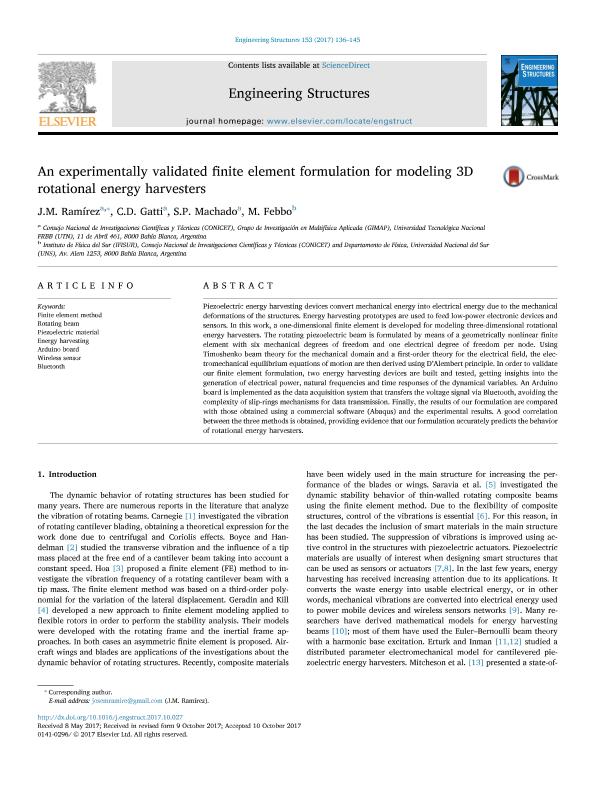Mostrar el registro sencillo del ítem
dc.contributor.author
Ramirez, Jose Miguel

dc.contributor.author
Gatti, Claudio David

dc.contributor.author
Machado, Sebastián Pablo

dc.contributor.author
Febbo, Mariano

dc.date.available
2018-10-31T18:03:48Z
dc.date.issued
2017-12-15
dc.identifier.citation
Ramirez, Jose Miguel; Gatti, Claudio David; Machado, Sebastián Pablo; Febbo, Mariano; An experimentally validated finite element formulation for modeling 3D rotational energy harvesters; Elsevier; Engineering Structures; 153; 15-12-2017; 136-145
dc.identifier.issn
0141-0296
dc.identifier.uri
http://hdl.handle.net/11336/63396
dc.description.abstract
Piezoelectric energy harvesting devices convert mechanical energy into electrical energy due to the mechanical deformations of the structures. Energy harvesting prototypes are used to feed low-power electronic devices and sensors. In this work, a one-dimensional finite element is developed for modeling three-dimensional rotational energy harvesters. The rotating piezoelectric beam is formulated by means of a geometrically nonlinear finite element with six mechanical degrees of freedom and one electrical degree of freedom per node. Using Timoshenko beam theory for the mechanical domain and a first-order theory for the electrical field, the electromechanical equilibrium equations of motion are then derived using D'Alembert principle. In order to validate our finite element formulation, two energy harvesting devices are built and tested, getting insights into the generation of electrical power, natural frequencies and time responses of the dynamical variables. An Arduino board is implemented as the data acquisition system that transfers the voltage signal via Bluetooth, avoiding the complexity of slip-rings mechanisms for data transmission. Finally, the results of our formulation are compared with those obtained using a commercial software (Abaqus) and the experimental results. A good correlation between the three methods is obtained, providing evidence that our formulation accurately predicts the behavior of rotational energy harvesters.
dc.format
application/pdf
dc.language.iso
eng
dc.publisher
Elsevier

dc.rights
info:eu-repo/semantics/openAccess
dc.rights.uri
https://creativecommons.org/licenses/by-nc-nd/2.5/ar/
dc.subject
Arduino Board
dc.subject
Bluetooth
dc.subject
Energy Harvesting
dc.subject
Finite Element Method
dc.subject
Piezoelectric Material
dc.subject
Rotating Beam
dc.subject
Wireless Sensor
dc.subject.classification
Ingeniería Mecánica

dc.subject.classification
Ingeniería Mecánica

dc.subject.classification
INGENIERÍAS Y TECNOLOGÍAS

dc.title
An experimentally validated finite element formulation for modeling 3D rotational energy harvesters
dc.type
info:eu-repo/semantics/article
dc.type
info:ar-repo/semantics/artículo
dc.type
info:eu-repo/semantics/publishedVersion
dc.date.updated
2018-10-22T18:01:00Z
dc.journal.volume
153
dc.journal.pagination
136-145
dc.journal.pais
Países Bajos

dc.journal.ciudad
Amsterdam
dc.description.fil
Fil: Ramirez, Jose Miguel. Universidad Tecnológica Nacional. Facultad Regional Bahía Blanca; Argentina. Consejo Nacional de Investigaciones Científicas y Técnicas; Argentina
dc.description.fil
Fil: Gatti, Claudio David. Universidad Tecnológica Nacional. Facultad Regional Bahía Blanca; Argentina. Consejo Nacional de Investigaciones Científicas y Técnicas; Argentina
dc.description.fil
Fil: Machado, Sebastián Pablo. Universidad Tecnológica Nacional. Facultad Regional Bahía Blanca; Argentina. Consejo Nacional de Investigaciones Científicas y Técnicas; Argentina
dc.description.fil
Fil: Febbo, Mariano. Consejo Nacional de Investigaciones Científicas y Técnicas. Centro Científico Tecnológico Conicet - Bahía Blanca. Instituto de Física del Sur. Universidad Nacional del Sur. Departamento de Física. Instituto de Física del Sur; Argentina
dc.journal.title
Engineering Structures

dc.relation.alternativeid
info:eu-repo/semantics/altIdentifier/url/https://www.sciencedirect.com/science/article/pii/S0141029617315742
dc.relation.alternativeid
info:eu-repo/semantics/altIdentifier/doi/http://dx.doi.org/10.1016/j.engstruct.2017.10.027
Archivos asociados
